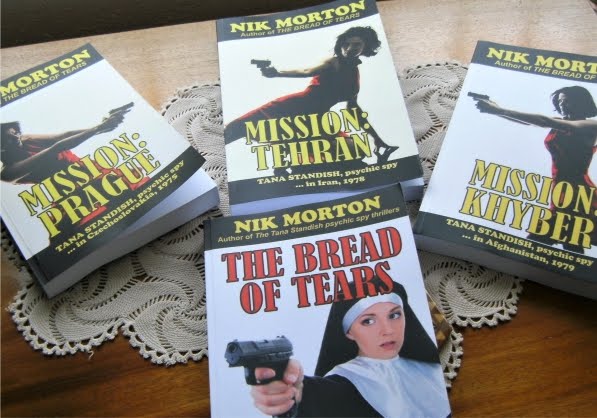Bilbao is dominated by the green slopes of
the surrounding mountains, even beyond the high-rise buildings. The city’s busy reinventing itself, its steel
mills and shipyards being transformed into conference centres and luxury flats,
and of course there’s the famous Guggenheim Museum (opened in 1997 and featured
in the Bond movie The World is Not Enough)
which has generated a tourism boom. The
city celebrated its 700th anniversary and is worthy of an article in
its own right. We drove round the edge
of sprawling Bilbao as the dark receded.
It’s strange how quickly you adapt to
driving on the other side of the road – even with a right-hand drive car. Reading the smaller numbers on the speedometer’s
kph dial soon became second-nature. We
had no intention of falling foul of speed restrictions here – though there were
very few speed cameras in evidence.
It was overcast and dull. Not surprising, really, as the north of Spain
gets more than its fair share of rain and is green most of the year as a
result. One motorway sign we came across
was of a raining cloud and a ‘100’ kph limit – warning motorists to reduce
speed from the standard 120 on this section when it rains. As we climbed into the surrounding mountains
it did start to rain. Another motorway
sign showed a huge snowflake, warning of possible snow. We saw two snow-ploughs driving up an
adjacent road. (Less than four days
later this journey would have been through heavy snow, these selfsame ploughs
working overtime to keep roads clear).
We turned onto the A68 or E80 – many roads
have a European number as well as a national one.
The only toll booth we encountered in our
530-mile drive south was at Junction 3 where we picked up an entry ticket and
would be charged further south. We now
met mist and low-lying cloud. Our
daughter Hannah rang on the mobile so we gave her a weather report as we drove
through fog. A ten minute stop at a
service area exotically named Area de Quintanapalla where we enjoyed tortilla
and coffee.
A few years ago some Eurocrat busybodies
tried to get the enormous black Osborne bull-silhouette advertisements taken
down; a sensible compromise was arrived at whereby the company name would be
removed but the bulls could stay since they were synonymous with the image of
Spain. We passed the first of five of
these bulls on the Burgos southern bypass signposted Valladolid, Madrid and the
second on the approach to the N1, the end of the motorway, and paid the toll.
Burgos was the home of El Cid in the
eleventh century and was the base two centuries later for Fernando el Santo to
reconquer Murcia, Cordoba and Seville.
Fernando started the building of Burgos’s cathedral, one of the greatest
in all Spain.
Still keen to find the sunshine we’d
promised it, our trusty car climbed to one of the highest points in the Puerto
de Somosierra area – 1440 metres - and met sleet and snow. One of the tapes we played was Placido Domingo,
singing the American Hymn from East of Eden, and the words held a little
significance for us both: ‘I dreamed of Eden all my life and now … where ever I go across the land I stand so proudly
in the sun and say “I am home”’ – though the sun still had to make an
appearance!
Now we joined the toll-free motorway M40, the Madrid western bypass and followed the signs for the Aeropuerto – not that we were considering flying out through lack of sun or anything, just following directions … Essentially, this ring-road round Madrid was clear for us though vehicles travelling in the other direction were at a standstill, echoing our beloved M25 no doubt.
Eventually we turned onto the A3 for
Valencia – the Avenida Mediterraneo - for a short while, joining the A31 and
stayed with this road for some 176 kilometres following the signs to
Albacete. From a psychological
standpoint, you feel you’re covering a lot of ground as the kilometres rather
than miles count down on the road-signs.
Now – at last! - the land was filled with sunshine, the ploughed fields a deep russet colour contrasting with the green trees and cultivated hills. Rise after rise displayed modern wind turbines, graceful against the blue skyline, like small armies frozen in time while on the march. Here you could imagine a modern-day Don Quixote tilting at these windmills.
After 275 miles we filled up with CEPSA
petrol and soon afterwards sighted two more bulls.
We passed under the hill-top fortress of
Chinchilla de Monte Aragon but didn’t linger for the view as we still had over
150 kilometers to go. A short run down
the N430 then onto the N330 for seventy-five km and we were in familiar
territory, the Alicante region and arrived at 6:30pm as dusk turned into
night. We’d covered some 815km in ten
hours, with stops. It was a lot easier
unloading than loading the car. We’d
arrived at our temporary residence, a base from where we would seek a permanent
home under Spanish skies.
And just a week later on Christmas Day we
were sitting with friends on the roof under those clear blue skies eating a
traditional turkey meal with all the trimmings.
[Note: Not every Christmas lunch can be eaten out, sometimes it's just a bit too cold; the nights are cold too. But the skies are usually gloriously clear blue! Then, petrol was about 81 cents a litre, now it's 1 euro 41 cents!]



























No comments:
Post a Comment